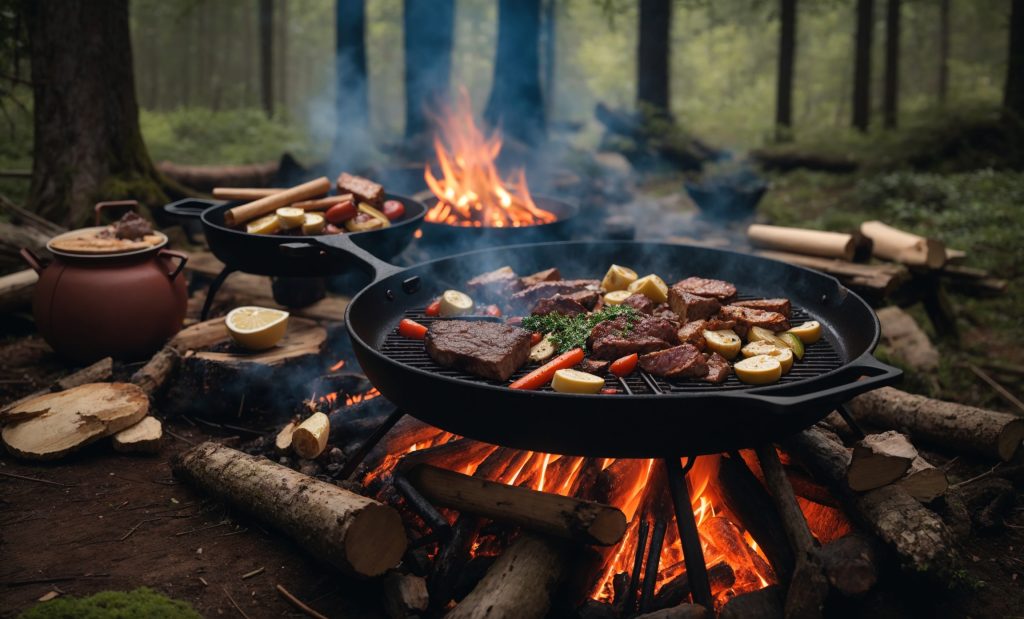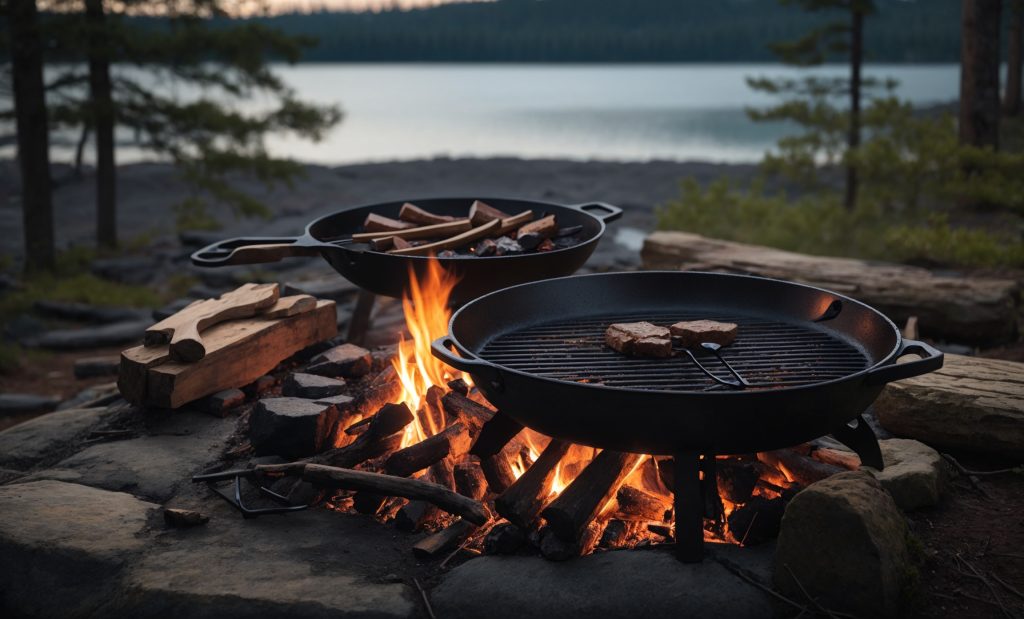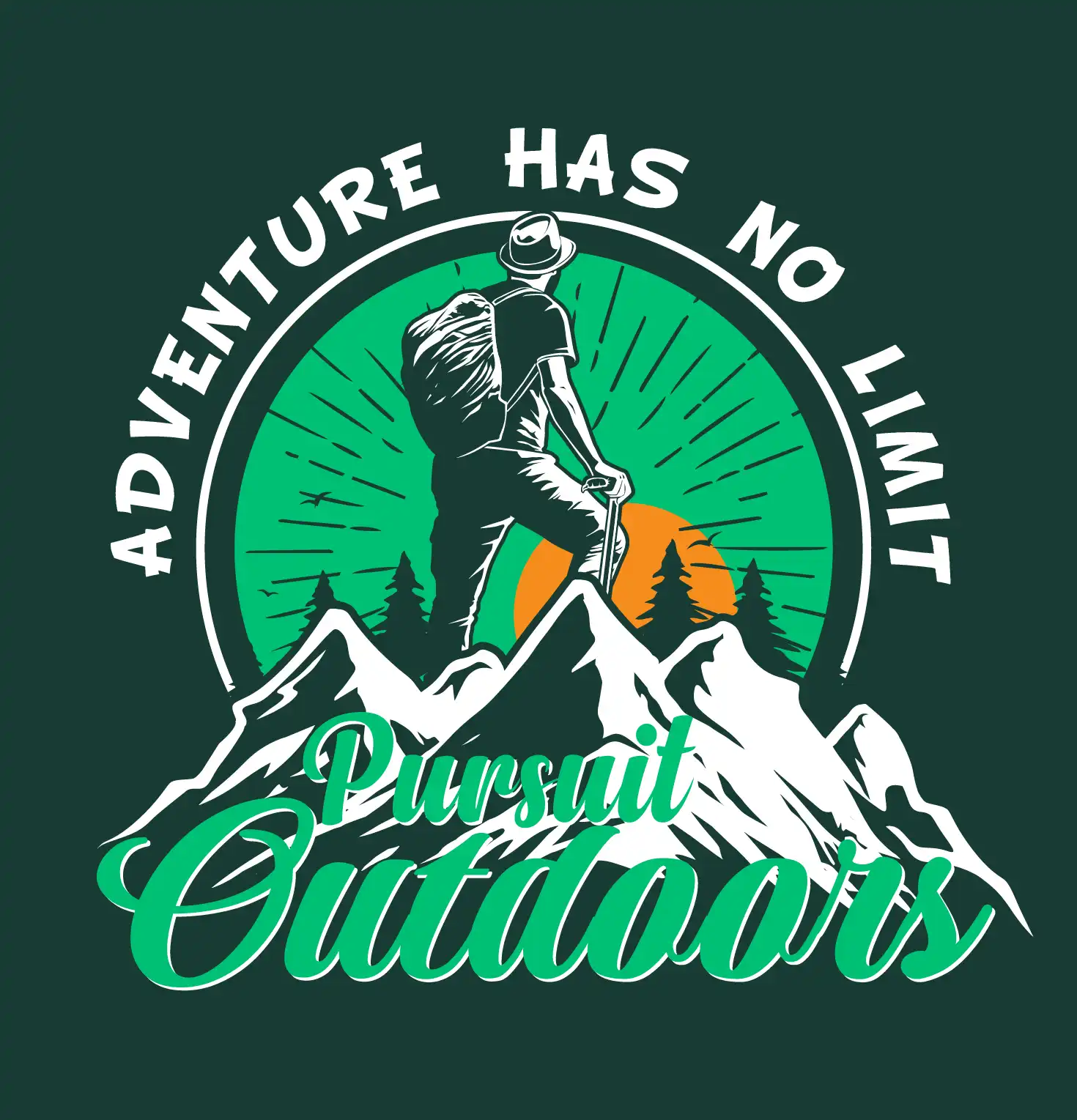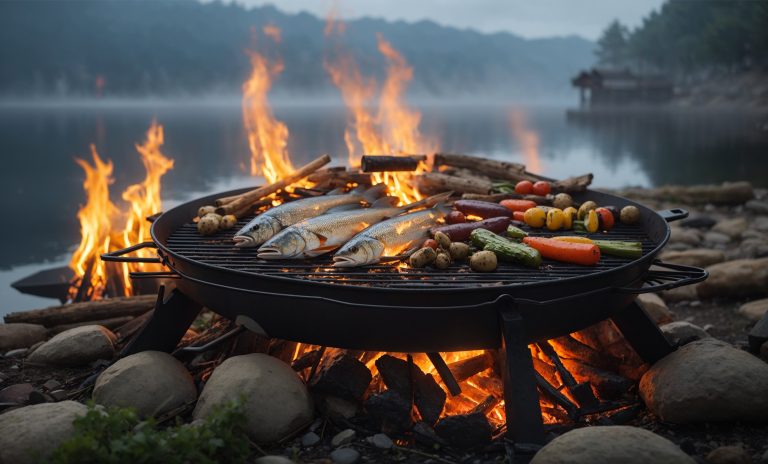Hey there, adventurers! Ever wondered what campfire cooking essentials for every adventure you should pack?
Well, you’re in the right place. This isn’t just about grilling some marshmallows—oh no, it’s about leveling up your outdoor culinary game!
After all, there’s something magical about a hot meal under the open sky, am I right?
So let’s dive into the gear that’ll turn you into the Gordon Ramsay of the great outdoors. Buckle up, this is gonna be a tasty ride.
Why Proper Gear Matters
Okay, so let’s talk gear. Having the right tools isn’t a luxury—it’s a necessity.
Imagine trying to flip a steak with a twig because you forgot the spatula. Hilarious, but not practical!
The right gear gives you the freedom to cook a variety of meals, not just “stick food” like sausages and marshmallows.
Now, let’s pivot to safety, ’cause we’re playing with fire, literally. Your adorable camping spork isn’t gonna cut it when you’re dealing with a roaring campfire.
Heavy-duty tongs and heat-resistant gloves are a must to avoid any “ouch” moments. And for Pete’s sake, don’t forget a fire extinguisher or a bucket of sand; better safe than sorry!
So, are you starting to see how having the right tools is crucial?
It’s not just about avoiding culinary catastrophes, but also about keeping your digits intact!
Feeling pumped? Good! Let’s keep the flame burning, and continue our journey to campfire cooking nirvana. Remember, adventure is out there, and it’s calling your name. Are you ready to answer with a feast?
Investing in specialized campfire cooking kits can significantly simplify your outdoor culinary endeavors, offering a well-curated set of tools designed specifically for the challenges of cooking in the wild.
There you go! I’ve got more sizzling advice coming your way, so stay tuned! I hope this section gives you some food for thought (pun totally intended).
Can’t wait to share the next juicy tidbits with you. Stay tuned for more! 🌲🔥🍳
Types of Campfires for Cooking
Alright, folks, now that we’ve got our gear sorted, let’s talk fire. Not all campfires are created equal, especially when it comes to cooking.

Believe me, choosing the right kind of fire is like picking the right wine for your dish. Let’s break down the major types, and why each is a game-changer for your outdoor feast.
Teepee Fire
Raise your hand if you’ve only ever thought of teepee fires for storytelling and s’mores!
Well, they’ve got another superpower: boiling water and making soup. Here’s the deal: A teepee fire concentrates heat upwards. This makes it perfect for bringing that pot of water to a rolling boil or simmering a delicious campfire soup.
Log Cabin Fire
Welcome to the outdoor grill master’s paradise: the log cabin fire. This bad boy provides a stable, flat surface for your grilling rack. Why does that matter?
Well, it allows for even cooking. That’s a big win if you’re looking to grill steaks, burgers, or even veggies. The structure also means you’ve got a controlled fire, making it easier to manage your cooking temps.
Lean-to Fire
So, got a stew or chili recipe that needs some slow cooking’?
Lean-to fires are your best friend. The setup allows for a longer, slower burn.
The heat isn’t as intense, which is exactly what you want for those dishes that need time for all the flavors to get to know each other.
Here’s why it’s so perfect:
With a lean-to fire, you can move your pot closer or further from the flames, giving you control over the cooking speed. And who doesn’t love a good, hearty stew after a day of hiking, fishing, or just lounging in a hammock?
So, whether you’re boiling, grilling, or slow-cooking, picking the right fire is crucial. Trust me, your taste buds will thank you!
Basic Cooking Tools and Gear
Alright, let’s dig into the fun stuff. The tools you bring along are the unsung heroes of your campfire cooking adventure.
Trust me, you don’t want to be stuck in the woods wishing you had that one crucial utensil. So, let’s ensure your toolkit is as ready as you are for the culinary journey ahead!

Cookware
You want your meals to taste like something off a gourmet menu, not like they were scraped off a rock.
Enter cast iron skillets, pots, and pans. Why cast iron?
Well, they’re durable, retain heat well, and they add a rustic flavor to your food. Plus, they’re versatile—you can go from frying bacon to baking cornbread in the same pan!
Here’s a tip:
Look for ones with a handle and a lid. The handle makes it easier to move, and the lid speeds up cooking and keeps those pesky bugs away.
Utensils
Think of this as your campfire cooking Swiss Army knife—tongs, spatulas, and even a good ol’ wooden spoon.
Tongs are crucial for flipping meat or tossing veggies on the grill. A spatula? Non-negotiable for things like burgers or fish.
And let’s not forget the utility player: the wooden spoon, perfect for stirring your bubbling pot of deliciousness.
My recommendation? Get a set of utensils specifically designed for camping.
They usually come in a roll-up bag, making them easy to store and carry.
Campfire Grill Grate
Okay, for those of you who want to get that authentic, smoky, “I’m a wilderness chef” vibe, you’ll need a campfire grill grate.
It allows you to cook directly over the fire, giving you that unbeatable charred flavor. Great for steaks, corn on the cob, and even some brave attempts at flatbreads!
So, what to look for?
Go for a grate with foldable legs and a sturdy build. This makes it stable over the fire and easy to pack when you’re on the move.
Advanced Tools for the Gourmet Adventurer
So you’ve mastered the basics, huh?
You can grill a steak without burning it and your campfire oatmeal doesn’t taste like cardboard anymore.
Nice work!
But now, you’re craving a challenge, something to elevate your outdoor cooking from great to gourmet. Hold onto your camping hats, folks, we’re diving into advanced territory!
Dutch Oven
Ah, the Dutch Oven, the Swiss Army knife of campfire cookery. From savory stews to lip-smacking desserts, this heavyweight can do it all. And the best part?
The thick walls and tight-fitting lid retain heat phenomenally well, turning your campfire into a bona fide oven.
Want to impress your fellow campers?
Try making a loaf of bread in a Dutch oven. Nothing beats the smell of freshly baked bread wafting through the forest!
Portable Smoker
For the carnivores out there, behold the portable smoker. This isn’t for the faint-hearted or the impatient—smoking meat is an art, my friends. But oh, the rewards are worth it: smoky, juicy meat that’ll make you the legend of any camping trip.
Here’s a pro tip:
Consider a smoker with multiple racks and a temperature gauge for more control and versatility.
Solar Oven
And for the eco-conscious, may I present the solar oven. Yep, you heard me right. Harness the power of the sun to bake, roast, or steam your food.
It’s a slow cooking process, but incredibly rewarding and perfect for those lazy camping days.
Imagine this:
You set up your solar oven, pop in a casserole, and go for a hike. By the time you’re back, dinner is served, no fuel needed. Talk about cooking with a clean conscience!
Cooking Safety and Environmental Considerations
Hey, I know, I know.
Safety and environmental chats can be a bit of a snooze-fest. But stick with me here.
Because let’s be real, nothing puts a damper on a camping trip like a forest fire or a littered campsite.
So, let’s go through some must-knows to keep your outdoor cooking shenanigans both safe and eco-friendly.
Fire Safety
First off, starting a fire. This ain’t a game, folks. Keep a bucket of water or a shovel nearby. Why?
In case things go sideways, you’ll want to act fast.
Now, about putting out that fire.
Drown it. Stir it. Then drown it again. Make sure it’s cold to the touch before leaving. No half-measures here; we’re aiming for Smokey the Bear’s stamp of approval.
Environmental Impact
Okay, onto the earth-lovin’ part. Ever heard of Leave No Trace?
It’s not just a catchy slogan; it’s a way of life in the great outdoors.
Dispose of your waste properly. And by “properly,” I mean pack it up and take it with you.
Not fun, but necessary.
Also, only use small sticks and twigs for your fire. Avoid breaking branches off living trees. It’s their home too, ya know?
But here’s the real kicker:
Make sure your fire is fully out before you leave. Why?
Because that smoldering ash could catch wind and start a new fire.
Tips and Tricks for Campfire Cooking
So you’ve got your gear and you know your safety stuff. Great!
But let’s dive into some game-changing tips that’ll make you the campfire Gordon Ramsay.
Prepping Ingredients Beforehand
Plan ahead, my friends. Chop your veggies and marinate that meat before leaving home. It’ll save you time and stress. Plus, nobody wants to be slicing onions with a pocket knife in the dark, am I right?
Using Foil for Easy Cooking and Clean-Up
Foil packets are your new BFF. Think of them as little cooking pouches.
Just toss in some veggies, maybe some fish, and you’re good to go. And the best part?
Minimal clean-up. That’s a win in my book.
Cooking Timing and Fire Management
Now let’s talk timing. A roaring fire is great for ghost stories, but not for your pot roast. Lower flames are your go-to for slow cooking. And if you’re in a hurry, wait for those embers. Hot and fast, baby!
FAQs
What are the must-have tools for campfire cooking for beginners?
For beginners, a sturdy cast-iron skillet, fire-resistant gloves, and a set of long tongs are must-haves for a hassle-free campfire cooking experience.
How do you maintain a cooking fire?
Maintaining a cooking fire involves regularly adding smaller pieces of wood to keep it burning at a consistent temperature, and using a stick to adjust logs for even heat distribution.
Can you cook anything over a campfire that you can cook at home?
Technically, yes, but keep in mind that some dishes are easier to manage over a campfire, such as grilled meats and one-pot meals, while baked goods might be more challenging.
How do you cook without generating waste?
Opt for reusable cookware and utensils, use biodegradable soap for cleaning, and follow Leave No Trace principles to minimize environmental impact while cooking.
Conclusion
Alright, folks, let’s wrap this up. Being prepared isn’t just for Scouts; it’s the key to a killer campfire cooking experience. Get the right gear, know your safety, and embrace those little hacks that make life easier.
So what are you waiting for?
Grab that skillet, gather some friends, and get out there. Your next campfire-cooked masterpiece awaits! 🌲🔥
Happy adventuring, everyone!

Anthony is a passionate outdoor enthusiast with a love for adventure and exploring the great outdoors. With years of experience hiking, camping, and rafting, he has a wealth of knowledge to share with others. Anthony’s writing captures the essence of his experiences, offering readers insights into some of the most beautiful and breathtaking landscapes in the world. Follow his journey and join the conversation as he continues to share his passion for the great outdoors.

